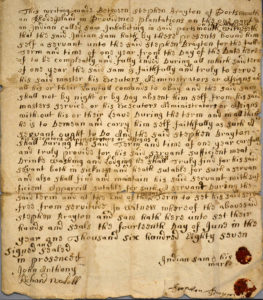Location: Richard I. Burnham Resource Center, 82 Touro Street, Newport
Monday-Friday, 9am-3pm, May-December 2025.
 How would you respond to the call of the Revolution?
How would you respond to the call of the Revolution?
Explore the lives and choices of Patriots and Loyalists in Colonial Newport and learn how they made history in turbulent times.
In the Newport Historical Society’s latest exhibition, follow along as six Newporters navigate the everyday dilemmas of a city awaiting the Revolution’s spark. Discover how information spread, opinions were influenced, and uncertainty took hold on the eve of the Revolution. Featuring interactive displays, period artifacts, daily reporting in local media, and a 17thcentury printing press, Newport 1775: Whose Side Are You On? is on view from May 15 through December, free of charge, at the Newport Historical Society’s Richard I. Burnham Resource Center.

Location: Brick Market, 127 Thames Street, Newport
Daily, 10am-4pm.
Since its inception in 1993, the multidimensional Museum of Newport History at the Brick Market has examined Newport County’s history through the use of images, objects, and texts. The items on display at the Museum make up less than five percent of the Newport Historical Society’s collection, which includes over 10,000 objects, 500 paintings, prints, and maps, and 200,000 photographs.
Exhibits feature the figurehead from the yacht Aloha, photographs, furniture, colonial silver, paintings, objects of daily life and more, all from the collections of the Newport Historical Society. With the use of these items, the Museum interprets Newport from its colonized settlement in 1639 through the twentieth century.
Location: Brick Market, 127 Thames Street, Newport

Estate inventory of Scipio Tanner, a free Black Newporter. August 4, 1819, Probate Volume 5, Page 531, Newport City Hall.
In 1696 the ship Seaflower landed in Newport harbor and sold 14 captive Africans into slavery here. This event marked the beginning of what would become Newport’s deeply entrenched role in the transatlantic slave trade. Between 1650 and 1860, slave traders trafficked roughly ten to fifteen million enslaved Africans to the Americas; an estimated 60% of these voyages started in Rhode Island.
By the third quarter of the eighteenth century, a free community of Black business owners, property owners and community leaders emerged. Clustering on the Point neighborhood, Pope, William, and Levin Streets—all on the margins of the city at that time—free Black leaders created the Free African Union Society, a mutual aid and self-help organization that supported the Black community within a landscape of slavery. The documents and artifacts they left behind give us some clues about their lives in colonial Newport and the period shortly after the Revolutionary War.
Visit the exhibit in-person at the Brick Market.
Location: Brick Market, 127 Thames Street, Newport; Online at www.nahr-nhs.com

Indenture, Indian Sam
(June 14, 1687), FIC.2020.130, Collections of the Newport Historical Society
In 1638 the first European settlers on Aquidneck Island purchased settlement rights from Canonicus and Miantonomi, sachems of the Narragansett tribe. The agreement, signed by both the colonists and Native Americans, stated that the current inhabitants would remove from the island. The first Europeans to settle permanently were Anne Hutchinson and her followers, who had been banished from Massachusetts Bay Colony. They settled at present day Portsmouth. By the following year, disagreements within the group led to an offshoot settling at the southern tip of the island in present day Newport.
There is abundant evidence, however, that the Native people did not entirely abandon Aquidneck Island, but rather continued to make use of this land, while finding ways to adapt to the presence of European settlements. In addition, the Native people of South County were actively engaged in business and other activities that took them to Newport. This evidence is found in legal and court records; in merchant, tradesman, and doctor’s account books; in letters and reminiscences, and even in the artifacts of the Colonial period. This story has not been part of the dominant narrative of Newport’s development, which rather ignores the presence of Native peoples once the British colonists arrive. But it exists, as do the descendants of the people who left their mark in the record. Both deserve recognition.
Visit the exhibit in-person at the Brick Market, or online at www.nahr-nhs.com
Location: Brick Market, 127 Thames Street, Newport
For over three hundred years the Newport Tower, locally known as the Old Stone Mill, has stood atop the hill in what is now Touro Park. Over time, a myriad of theories about its intended use, dates of construction, and the identity of its builders have been discussed. Visit this exhibition to see the most prevalent theories about the tower’s history, and the evidence used to argue each position. We encourage you to think like an historian, analyze the information presented, and draw your own conclusion about the Newport Tower.
